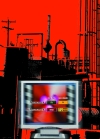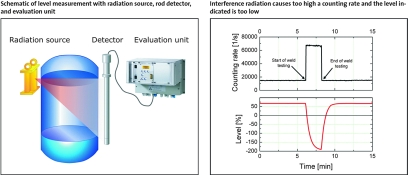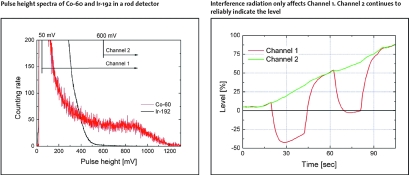

Radiometric measurement
In the case of difficult measuring tasks – complex vessels with internal mechanics, high pressures, or aggressive media – there is no alternative to the use of radiometric level measurement.
Radiometric level measuring devices permit non-contact measurement. They consist of a (weak) radiation source and a rod detector placed on opposite sides of a vessel. The source is surrounded by a lead shield which allows radiation to emanate only in the direction of the vessel. Part of the radiation penetrates the vessel walls and reaches the detector. If the level rises the radiation is attenuated and the counting rate at the detector decreases.
The technique permits non-contact level measurement and is therefore used especially for difficult measuring tasks. Until recently, however, radiometric measurements were always compromised whenever testing of materials or welds was being performed on site. A newly developed technology now permits the influence of interference radiation on measurement to be drastically reduced.
The very high radiation levels used for weld testing are sufficient to wreak havoc in radiometric sensors at distances of up to 1 km from the source. A new technology has been developed to prevent this from happening. An LB440-RID radiometric level measurement system incorporating this new technology was subjected to extensive field testing by BASF radiometry specialists at Ludwigshafen in collaboration with Berthold Technologies in order to establish its applicability in practice.
At BASF there is a need to automatically control the liquid level in the sump of a distillation column in a production plant over a measuring range of 1,8 m. The key challenge at this measuring point is the demand for a high accuracy corresponding to 1% of the measuring range and a high level of reliability.
Previously, measurements were performed according to the principle of differential pressure. However, the measuring probe very soon became contaminated and gave false level values, meaning that the product could no longer be produced within the required specifications. There was a danger that 'bad' product would contaminate the 'good' product held in the storage tanks.
The required accuracy and reliability could only be achieved through installation of a radiometric level measurement system. The control system has now been functioning faultlessly for many months and the product has been consistently produced in the desired quality ever since.
Problem
There is a workshop for the production of piping in the immediate vicinity of the production building. About once a week at irregular intervals radiometric weld tests are conducted in this workshop. The radiation strength for this testing was some 40 000 times greater than that emitted by the production level probe source. (Selenium 75 radiation sources with an activity of up to 2500 GBq are used - compare this to the 0,06 GBq of the cobalt 60 source used for level measurement.)
Further weld testing in the vicinity, eg, on pipe bridges or during reconstruction work in neighbouring buildings, acerbates the situation. The neighbouring production units are informed in advance of weld testing and during this time - usually two to four hours - control of the liquid level is performed manually.
This means that a production employee has to constantly monitor the level control during this period. The employee is distracted and is unable to devote his or her full attention to the primary task at hand. Manual level control can lead to difficulties in column operation. There is a risk of obtaining off-specification product.
In order to minimise the effect of interference radiation on measurements, the possibility of fitting the 2 m long detector with a lead jacket as protection against extraneous radiation was considered. Drawbacks of this approach are the high costs of material and production of such a radiation shield. Moreover, the mounting of such a jacket weighing up to 500 kg would be mechanically demanding. Since the detector would have to remain unshielded in the direction of the container, serious effects of interference radiation still cannot be reliably eliminated.
This problem was ultimately solved when the radiometry specialist unit of BASF installed the new LB440-RID radiometric liquid level measurement system incorporating suppression of interference radiation. The system was first subjected to an extensive testing programme.
The nuclide makes the difference
The LB440-RID system exploits the fact that different nuclides are used for level measurements and for weld tests. While the nuclides Co-60 (gamma energy equivalent to 1300 keV) and Cs-137 (gamma energy equivalent to 660 keV) are generally used for level measurements, the energy of the radiation of the nuclides Se-75 (equivalent to 400 keV) and Ir-192 (equivalent to 500 keV) used almost exclusively for weld testing is significantly lower.
If a quantum of radiation is incident upon the detector of the measuring system, it generates a short voltage pulse. The higher the energy of the absorbed quantum of radiation, the higher on average the resulting voltage pulse. In order to avoid the influence of background radiation and electronic noise on the measurement, only those pulses are counted which exceed the measuring threshold of 50 mV. Figure 1 shows the pulse height distribution of Co-60 and of Ir-192, as recorded with a rod detector.

Since Co-60 radiation has a higher energy than that of Ir-192, the voltage pulses generated by Co-60 are on average higher. If the threshold of the measuring electronics were to be raised from 50 to 600 mV, only the Co-60 radiation would contribute to the counting rate - the measurement would be insensitive to interference radiation. However, such an approach has the disadvantage that the majority of the Co-60 pulses lie below 600 mV and would no longer be counted.
Counteracting this merely by raising the emitter activity is precluded by the principles of radiation protection, which call for minimisation of activity. Moreover, interference radiation only occurs comparatively rarely and it is therefore nearly always possible to work with a low threshold and a high pulse rate.
The measuring system therefore works with two different thresholds, a low one at 50 mV (Channel 1) and a higher one at 600 mV (Channel 2). Thus in Channel 1 all the Co-60 and the interference radiation pulses are counted. Channel 2, on the other hand, only counts pulses greater than 600 mV, which stem almost exclusively from the Co-60 source. At the start of measurement, the two channels are calibrated such that the level in the container can be measured with both of them. In normal operation both channels show the same liquid level, but the evaluation unit reports only the value from Channel 1 for automatic level control.
If interference radiation reached the detector, the pulse rate in Channel 1 increases very dramatically and the indicated level consequently decreases, whereas Channel 2 remains unaffected. If the resulting difference in the value of the level between the two channels exceeds a preset tolerance value, the evaluation unit automatically switches the output signal from Channel 1 to Channel 2. During the action of interference radiation the liquid level is reliably determined from the signal from Channel 2.
After completion of weld testing, the liquid level according to Channel 1 returns to the normal level (Figure 1 right) and the evaluation unit switches back to the sensitive Channel 1. In this way, the influence of interference radiation on measurement could be reduced by a factor greater than 100.
The success of this approach requires that a sufficient energy difference exists between the measuring source and the extraneous radiation source. Existing level measuring systems fitted with Cs-137 sources therefore have to be adapted to Co-60. As a rule, no changes to the detector are required since only the software in the evaluation unit has to be updated to accommodate the new function.
Laboratory and field tests
Prior to installation, the system was subjected to extensive testing in the laboratory of the radiometric specialist unit of BASF. To this end, a radiometric level measurement system was set up on the existing laboratory test bed and interference radiation generated under conditions of rising and of falling liquid level. The system functioned in a reliable manner (Figure 2 right) and switched as expected from Channel 1 to Channel 2. The output current of the level measuring system correctly indicated increasing and decreasing liquid levels in spite of interference radiation.

Only then was the system installed on the sump of the distillation column in a production plant and connected to a data acquisition system. There too, the radiometric level measuring system was repeatedly exposed to interference radiation of various intensities. The system was irradiated from different directions both with Se-75 and with Ir-192. Such interference was reliably recognised and suppressed. Weld testing in neighbouring buildings also had only a minimal effect on measurements. However, in the case of very weak extraneous radiation, the required accuracy of 1% of the measuring range could not always be met. Since the system only switches over from Channel 1 to Channel 2 when the channel difference exceeds the tolerance value, it is not possible to suppress effects lower than equivalent to 3 % of level readings.
Since upgrading of level measurement to LB440-RID, radiometric measurement have been constantly available, even during weld testing. Manual operation is a thing of the past. It is planned to fit additional level measuring devices with automatic suppression of interference radiation in the course of modernisation and expansion of BASF at Ludwigshafen.
For more information contact Henning Springer, Mecosa, 011 257 6100, [email protected], www.mecosa.co.za
| Tel: | +27 11 257 6100 |
| Email: | [email protected] |
| www: | www.mecosa.co.za |
| Articles: | More information and articles about Mecosa |

© Technews Publishing (Pty) Ltd | All Rights Reserved